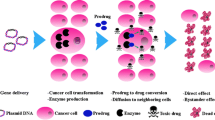Abstract
Gene-Directed Enzyme Prodrug Therapy (GDEPT), commonly known as suicide gene therapy, provides a selective approach to eradicate tumor cells that is currently considered as an alternate approach to conventional therapy for cancers due to its high efficacy. Herein, we have demonstrated functional activity of the cytosine deaminase (CD) and the hybrid cytosine deaminase-uracil phosphoribosyltransferase (CD-UPRT) suicide genes in transfected cell lines. We have monitored retention profiles of various metabolites that were formed during enzymatic conversion of the prodrug 5-flurocytosine (5-FC) using reverse phase HPLC method. Therapeutic effect of suicide genes was established by cell viability and toxicity assay, whereas apoptotic induction was confirmed by DNA fragmentation ELISA. Our results demonstrated that 5-FC/CD-UPRT-mediated apoptotic cell death was more than 5-FC/CD, which could be further potentiated with anticancer compound curcumin. Such results corroborated 5-FC/CD-UPRT in combination with curcumin as a better chemosensitization method.







Similar content being viewed by others
References
Bernt KM, Steinwaerder DS, Ni S et al (2002) Enzyme-activated prodrug therapy enhances tumor-specific replication of adenovirus vectors. Cancer Res 62:6089–6098
Chu RL, Post DE, Khuri FR et al (2004) Use of replicating oncolytic adenoviruses in combination therapy for cancer. Clin Cancer Res 10:5299–5312
Ghosh SS, Gopinath P, Ramesh A (2006) Adenoviral vectors: a promising tool for gene therapy. Appl Biochem Biotechnol 133:9–29
Gopinath P, Ghosh SS (2007) Monitoring green fluorescent protein for functional delivery of E. coli cytosine deaminase suicide gene and the effect of curcumin in vitro. Gene Ther Mol Biol 11:219–228
Gopinath P, Ghosh SS (2008) Apoptotic induction with bifunctional E. coli cytosine deaminase-uracil phosphoribosyltransferase mediated suicide gene therapy is synergized by curcumin treatment in vitro. Mol Biotechnol (DOI 10.1007/s12033-007-9026-3)
Harris JD, Gutierrez AA, Hurst HC et al (1994) Gene therapy for cancer using tumour-specific prodrug activation. Gene Ther 1:170–175
Hermiston T (2000) Gene-delivery from replication-selective viruses: arming guided missiles in the war against cancer. J Clin Invest 105:1169–1172
Holder JW, Elmore E, Barrett JC (1993) Gap junction function and cancer. Cancer Res 53:3475–3485
Hotz-Wagenblatt A, Shalloway D (1993) Gap junctional communication and neoplastic transformation. Crit Rev Oncog 4:541–558
Howells LM, Mitra A, Manson MM (2007) Comparison of oxaliplatin- and curcumin-mediated antiproliferative effects in colorectal cell lines. Int J Cancer 121:2929–2937
Kambara H, Tamiya T, Ono Y et al (2002) Combined radiation and gene therapy for brain tumors with adenovirus-mediated transfer of cytosine deaminase and uracil phosphoribosyltransferase genes. Cancer Gene Ther 9:840–845
Kanai F, Kawakami T, Hamada H et al (1998) Adenovirus-mediated transduction of Escherichia coli uracil phosphoribosyltransferase gene sensitizes cancer cells to low concentrations of 5-fluorouracil. Cancer Res 58:1946–1951
Kawamura K, Tasaki K, Hamada H et al (2000) Expression of Escherichia coli uracil phosphoribosyltransferase gene in murine colon carcinoma cells augments the antitumoral effect of 5-fluorouracil and induces protective immunity. Cancer Gene Ther 7:637–643
Khatri A, Zhang B, Doherty E et al (2006) Combination of cytosine deaminase with uracil phosphoribosyl transferase leads to local and distant bystander effects against RM1 prostate cancer in mice. J Gene Med 8:1086–1096
Marais R, Spooner RA, Light Y et al (1996) Gene-directed enzyme prodrug therapy with a mustard prodrug/carboxypeptidase G2 combination. Cancer Res 56:4735–4742
Miyagi T, Koshida K, Hori O et al (2003) Gene therapy for prostate cancer using the cytosine deaminase/uracil phosphoribosyltransferase suicide system. J Gene Med 5:30–37
Moolten FL (1986) Tumor chemosensitivity conferred by inserted herpes thymidine kinase genes: paradigm for a prospective cancer control strategy. Cancer Res 46:5276–5281
Moolten FL (1994) Drug sensitivity (“suicide”) genes for selective cancer chemotherapy. Cancer Gene Ther 1:279–287
Mullen CA, Kilstrup M, Blaese RM (1992) Transfer of the bacterial gene for cytosine deaminase to mammalian cells confers lethal sensitivity to 5-fluorocytosine: a negative selection system. Proc Natl Acad Sci USA 89:33–37
Pabbruwe MB, Stewart K, Chaudhuri JB (2005) A comparison of colorimetric and DNA quantification assays for the assessment of meniscal fibrochondrocyte proliferation in microcarrier culture. Biotechnol Lett 27:1451–1455
Pan J, Xu G, Yeung SJ (2001) Cytochrome C release is upstream to activation of Caspase-9, Caspase-8, and Caspase-3 in the enhanced apoptosis of anaplastic thyroid cancer cells induced by manumycin and paclitaxel. J Clin Endocr Metab 86:4731–4740
Pillai GR, Srivastava AS, Hassanein TI et al (2004) Induction of apoptosis in human lung cancer cells by curcumin. Cancer Lett 208:163–170
Rowley S, Lindauer M, Gebert JF et al (1996) Cytosine deaminase gene as a potential tool for the genetic therapy of colorectal cancer. J Surg Oncol 61:42–48
Shpitz B, Giladi N, Sagiv E et al (2006) Celecoxib and curcumin additively inhibit the growth of colorectal cancer in a rat model. Digestion 74:140–144
Springer CJ, Duvaz IN (2000) Prodrug-activating systems in suicide gene therapy. J Clin Invest 105:1161–1167
Tiraby M, Cazaux C, Baron M et al (1998) Concomitant expression of E. coli cytosine deaminase and uracil phosphoribosyltransferase improves the cytotoxicity of 5-fluorocytosine. FEMS Microbiol Lett 167:41–49
Xia K, Liang D, Tang A et al (2004) A novel fusion suicide gene yeast CDglyTK plays a role in radio-gene therapy of nasopharyngeal carcinoma. Cancer Gene Ther 11:790–796
Acknowledgements
This work was financially supported by the Department of Biotechnology [BT/PR9988/NNT/28/76/2007] and Council of Scientific and Industrial Research [No.37 (1248)/06/EMRII] Government of India.
Author information
Authors and Affiliations
Corresponding author
Rights and permissions
About this article
Cite this article
Gopinath, P., Ghosh, S.S. Implication of functional activity for determining therapeutic efficacy of suicide genes in vitro. Biotechnol Lett 30, 1913–1921 (2008). https://doi.org/10.1007/s10529-008-9787-1
Received:
Revised:
Accepted:
Published:
Issue Date:
DOI: https://doi.org/10.1007/s10529-008-9787-1




